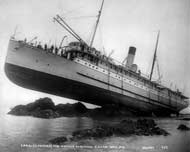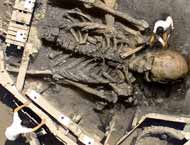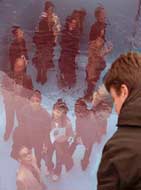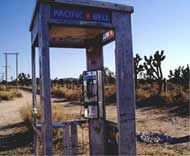Economy of Effort
News and Site Updates Archive 2010/10/15When someone tells you they’ve just bought a house, they might as well tell you they no longer have a personality. — Douglas Coupland 
The United States is running out of time to get its budget and trade deficits under control. Cuts in Social Security and Medicare, for which people have paid 15% of their earnings all their lives, could result in starvation and deaths from curable diseases. Tax increases make even less sense — the majority of households can't survive on one job. Both husband and wife work and often one of them has two jobs in order to make ends meet. Raising taxes makes that harder — thus more foreclosures, food stamps, and homelessness. Tax the rich? They can simply stop earning. Levy a tax on private pensions on the grounds that the pensions have accumulated tax-deferred, or else require pension fund managers to purchase Treasury debt. This might buy a little more time. The only remaining financier is the Federal Reserve. When Treasury bonds brought to auction don't sell, the Federal Reserve must buy them by expanding the money supply. The collapsing economy means a bigger deficit to finance in the future. Just how high can it go? The dollar's devaluation will likely result in it no longer being the reserve currency. Inflation is inevitable then. Not enough money for fuel will have far-reaching effects. What to do? Stop the wars and downsize the military for starters. (But I don't really see that happening in the near term.) 
A group of people, through a combination of social organisation and environmental luck, finds itself with a surplus of resources. Managing this surplus makes society more complex — agriculture rewards mathematical skill, granaries require new forms of construction, and so on. Early on, the marginal value of this complexity is positive — each additional bit of complexity more than pays for itself in improved output — but over time, the law of diminishing returns reduces the marginal value, until it disappears completely. At this point, any additional complexity is pure cost. When society's elite members add one layer of bureaucracy or demand one tribute too many, they end up extracting all the value from their environment it is possible to extract and then some. The "...and then some" is what causes the trouble. Complex societies collapse because, when some stress comes, those societies have become too inflexible to respond. In such systems, there is no way to make things a little bit simpler — the whole edifice becomes a huge, interlocking system not readily amenable to change. Collapse may be the most appropriate response. 
The US is bankrupt. Neither spending more nor taxing less will help the country pay its bills. What it can and must do is to radically simplify its tax, health-care, retirement and financial systems, each of which is a complete mess. The International Monetary Fund released its annual review of US economic policy: "The US fiscal gap associated with today’s federal fiscal policy is huge for plausible discount rates." It adds that "closing the fiscal gap requires a permanent annual fiscal adjustment equal to about 14% of US GDP." The fiscal gap is the value today (the present value) of the difference between projected spending (including servicing official debt) and projected revenue in all future years. To put 14% of GDP in perspective, current federal revenue totals 14.9% of GDP. So the IMF is saying that closing the US fiscal gap, from the revenue side, requires, roughly speaking, an immediate and permanent doubling of personal-income, corporate and federal taxes as well as the payroll levy set down in the Federal Insurance Contribution Act (not that that would ever happen, but just to put things into perspective). The IMF also says the longer the country waits to make tough fiscal adjustments, the more painful they will be. Something that can’t go on, will stop. And it will stop in a very nasty manner. The first possibility is massive benefit cuts visited on the baby boomers in retirement. The second is astronomical tax increases that leave the young with little incentive to work and save. And the third is the government simply printing vast quantities of money to cover its bills (this is no solution at all but merely a delaying tactic). The US can no longer afford no-pain, all-gain "solutions." 
Chalmers Johnson, former consultant for the CIA, head of the Center for Chinese Studies, UC Berkeley and president, Japan Policy Research Institute: "It may, for all we know, still be Hollywood’s century for decades more, and so we may still make waves on the cultural scene, just as Britain did in the 1960s with the Beatles and Twiggy. Tourists will undoubtedly still visit some of our natural wonders and perhaps a few of our less scruffy cities, partly because the dollar-exchange rate is likely to be in their favour. If, however, we were to dismantle our empire of military bases and redirect our economy toward productive, instead of destructive, industries; if we maintain our volunteer armed forces primarily to defend our own shores (and perhaps to be used at the behest of the United Nations), if we began to invest in our infrastructure, education, health care, and savings, then we might have a chance to reinvent ourselves as a productive, normal nation." Dmitry Orlov, Russian author: "I anticipate that some people will react rather badly to having their country compared to the USSR. The Soviet people would have reacted similarly, had the US collapsed first. Feelings aside, here are two 20th century superpowers, who wanted more or less the same things — technological progress, economic growth, full employment, world domination — but they disagreed about methods. And they obtained similar results — each had a good run, intimidated the whole planet and kept the other scared. Each eventually went bankrupt." What is the minimum number of people needed to maintain our current level of technological civilisation? How many does it take to design a new automobile? Back in Henry Ford's day, it took an office full of draughtsmen, senior engineers to sort out major mechanical subsystems (gear train, engine, electrics, brakes, suspension, bodywork), and experts on coachbuilding to dictate the shape. Time and motion men dictated the speed and sequence of assembly line activities; other draughtsmen designed tools for production line workers. It took effort from a few hundred men. But a typical 2010 automobile may contain 20 — 30 electric motors and actuators (central locking system, air conditioning, motorised seats, windows and more). A similar number of microprocessors are involved in everything from engine and gearbox management systems to entertainment, navigation, communication, and accident mitigation (for example, sensors and microprocessors that control the sequence of pyrotechnic detonators to inflate air bags, tension seat belts and collapse the steering column in a collision). The in-car electronics alone require 10 — 20 million lines of code to run all these services — which implies combined efforts of thousands of software developers (plus computer designers, testers, makers) never mind the small army who design not only body panels but handling tools that the production line robots use to install them. Cars aren't user-serviceable because they're nearly as complex as 1960s airliners. Space colonisation? Get back to me when you've tracked down how many people it takes to design and build a space suit. We won't have autonomous off-world colonies without tens of millions of people — or else we'll soon be leading much more primitive lives there as tools and appliances wear out. 
Necklacing is the practice of summary execution carried out by forcing a rubber tire (tyre) filled with petrol around a victim's chest and arms and igniting it. The victim may take up to 20 minutes to die, suffering severe burns in the process. It became a common method of lethal lynching during disturbances in South Africa in the 1980s and 1990s. Photojournalist Kevin Carter, first to photograph a public execution by necklacing in South Africa in the mid-1980s, later commented: "I was appalled at what they were doing — at what I was doing. But people started talking about those pictures. After having seen so many necklacings on the news, it occurs to me that either many others were being performed off camera — this was just the tip of the iceberg — or else the presence of the camera completed the last requirement and acted as a catalyst in this terrible reaction. Was the strong message that was being sent only meaningful if it were carried by the media? The question that haunts me is 'Would those people have been necklaced without media coverage?'" In 2006, at least one died by necklacing in Nigeria in the deadly Muslim protests over satirical cartoon drawings of Muhammad. In India, it was used in the 1984 anti-Sikh riots following the assassination of Indira Gandhi. The practice has been widely used by Brazilian drug dealers. 
Twelve Russian scientists famously chose to starve to death rather than eat the unique collection of seeds and plants they were protecting for humanity during the 900-day siege of Leningrad in the second world war. But the world's first global seed bank now faces destruction once more, to make way for a private housing estate. The fate of the Pavlovsk agricultural station outside St Petersburg will be decided in the courts. If, as expected, the case goes against it then the collection of plants built up over 85 years could be destroyed within months. More than 90% of the plants are found in no other research collection or seed bank. Its seeds and berries are thought to possess traits that could be crucial to maintaining productive fruit harvests in many parts of the world as climate change and a rising tide of disease, pests and drought weaken the varieties farmers now grow. As it is predominantly a field collection, Pavlovsk cannot be moved. Experts estimate that even if another site were available nearby, it would take many years to relocate the plants. In what appears Kafkaesque logic, the property developers argue that because the station contains a "priceless collection", no monetary value can be assigned to it and so it is worthless. In another nod to Kafka, the government's federal fund of residential real estate development has argued that the collection was never registered and thus does not officially exist. Via Tywkiwdbi 
To most Christians, the Bible is like a software licence. Nobody actually reads it. They just scroll to the bottom and click, "I agree." — Original Source Unknown Julia Gillard, the first female Australian prime minister, has said that she does not believe in God. Wow. It's about time. "I'm not going to pretend a faith I don't feel," she said. (Did this help of hurt her in the just past election?) In Dallas, Texas, where I grew up, I remember well the remnants of segregation — the white porcelain and separate black porcelain water fountains and the little metal signs on the buses that said "Whites to the front, Colored to the rear" on them. Can we really have been that cruel? Racial segregation is the separation of different kinds of humans into racial groups in daily life. It may apply to activities such as eating in a restaurant, drinking from a water fountain, using a washroom, attending school, going to the movies, or in the rental or purchase of a home. It is generally outlawed, but may exist through social norms, maintained by means ranging from discrimination in hiring and rental/sale of housing to vigilante violence (such as lynchings). Generally, a situation that arises when members of different races mutually prefer to associate and do business with members of their own race is commonly described as separation rather than segregation. In the US, legal segregation was required in some states (Texas was one) and there were prohibitions against interracial marriage. Laws were passed against segregation in the 1960s, but took much longer to be effectively enforced and — much more importantly — accepted. Until this year, the Nettleton Middle School in Nettleton, Mississippi had a rule that only white students were allowed to run in elections for class president. Mixed race? The school board said they "Go by the mother’s race because with minorities the father isn’t generally in the home." 

Most phytoplankton are too small to be individually seen with the unaided eye. However, when present in high enough numbers, they may appear as a green discoloration of the water due to the presence of chlorophyll within their cells. They account for half of all photosynthetic activity on Earth and are thus responsible for much of the oxygen present in the atmosphere. Since the 20th century, phytoplankton have declined by roughly 1% yearly, possibly linked to warming oceanic temperatures. As of 2010 this means a decline of 40% relative to 1950. (No one is sure exactly what impact this has.) There are about 5,000 species of marine phytoplankton. One group, the coccolithophorids, is responsible (in part) for the release of significant amounts of dimethyl sulfide (DMS) into the atmosphere. DMS is converted to sulfate and these sulfate molecules act as cloud condensation nuclei, increasing general cloud cover, hence cooling and rain. 
Genetic sequencing of sea sponges from the World Heritage-listed Great Barrier Reef shows the ancient marine animals share almost 70% of human genes, including a large number typically associated with disease and cancer. Sponges have what're (considered) the "Holy Grail" of stem cells. Exploring the genetic function of sponge stem cells could provide "deep and important connections" to the genes that influence human stem cell biology, including improving the way we use them in future medical applications. In other cell-related news: Genes in sperm may determine why female mammals live longer than males. Female mice produced from genetic material from two mothers, but not from a father, live significantly longer than mice with the normal mix of maternal and paternal genes. "Bi-maternal" mice are created by manipulating DNA in mouse eggs so that half the genes behave like those in sperm. 

Oceanographic sea-floor surveyors in the area around Bermuda and in the North Sea between continental Europe and Great Britain have discovered significant quantities of methane hydrates and old eruption sites. Methane is the apparent culprit behind mysterious disappearances and loss of ships and aircraft in these areas. Normally frozen at great pressure as gas hydrates embedded within subterranean rock, methane can become dislodged and transform into gaseous bubbles, which expand geometrically as they explode upward. At the water's surface, they soar into the air, still expanding up and out. Ships caught in one immediately lose buoyancy and sink. Aircraft falling victim to a giant bubble lose their engines, perhaps igniting the methane surrounding them. They lose lift and dive into the ocean, plummeting to the sea bottom. A ship sinks if it's between the middle of a bubble and the outer edge. Far enough out from the edge, the ship is safe. Positioned directly at the centre of a large methane bubble, everyone aboard the craft merely asphyxiates (accounting for several famous cases of ships found in these areas with everyone aboard dead without a scratch). As a bubble surfaces, water rises dramatically, creating a spherical shape. As the bubble bursts, a huge sheet of high-velocity water slams onto the ship, driving it into the murky depths. Recent North Sea surveys have identified sunken vessels near old methane venting/eruption sites. What a methane bubble actually looks like as it roars from the ocean depths, no one knows — anyone experiencing the phenomenon up close is dead. Large methane bubbles moving upwards to the surface at free rise speed would drag with them salty ocean water, thus generating loops and spirals of electromagnetic disturbance; these variations in electromagnetism would affect compasses and destroy the electrical equipment of ships and planes nearby. Distant streams of bright stars and dark dust that are part of the disk of our spiral Milky Way Galaxy. On the left, just above famous Pulpit Rock in Australia is the Milky Way's neighbouring galaxy the Small Magellanic Cloud (SMC). At right, the Milky Way is seen above wind generators near Lake Benton outside Hendricks, Minnesota on 6 August. These two pictures nicely illustrate the effect on the night sky of being in either the Northern or the Southern hemisphere. 
Culture, not just genes, can drive evolutionary outcomes, according to a study that compares individualist and group-oriented societies across the globe. Bridging a rarely-crossed border between natural and social sciences, the study looks at the interplay across 29 countries of two sets of data, one genetic and the other cultural. The researchers found that most people in countries widely described as collectivist have a specific mutation within a gene regulating the transport of serotonin, a neurochemical known to profoundly affect mood. As if that isn't odd enough: a snail comes, almost always, with the opening on the right hand side of the shell. Very occasionally — perhaps once in 10,000 times — a reversed, or "sinistral", individual turns up. Some American scientists claim that even the party one votes for, on the Left or the Right, is influenced by inherited variations in the DNA that codes for a certain brain receptor. Via Tywkiwdbi. 
Reverse sexual imprinting is seen when two people live in close domestic proximity during the first few years in either one's life. Both are desensitised to later close sexual attraction. This phenomenon was first formally described by Finnish anthropologist Edvard Westermarck in his book The History of Human Marriage (1891). The "Westermarck effect" has since been observed in many places and cultures, including Israeli kibbutzim and Chinese Shim-pua marriage customs, as well as in biologically related families. In the kibbutzim (collective farms), children were reared somewhat communally in peer groups based on age. A study of marriage patterns of these children later in life revealed that out of nearly 3,000 marriages that occurred across the kibbutz system, only 14 were between children from the same peer group. Of those 14, none had been reared together during the first 6 years of life. This result not only provides evidence of the Westermarck effect, but shows that it operates during the period from birth to the age of 6. When proximity during this critical period doesn't occur — for example, where a brother and sister are brought up separately, never meeting one another — they may find each other highly sexually attractive when they meet as adults. This phenomenon is known as genetic sexual attraction. This observation supports the hypothesis that the Westermarck effect evolved because it suppresses inbreeding. This attraction is also seen with cousin couples. Freud argued that as children, members of the same family naturally lust for one another, making it necessary for societies to create incest taboos but Westermarck argued the reverse, that the taboos themselves arise naturally as products of innate attitudes. Steven Pinker, in How the Mind Works wrote on the subject: "The idea that boys want to sleep with their mothers strikes most men as the silliest thing they have ever heard. Obviously, it didn't seem so to Freud, who wrote that as a boy he once had an erotic reaction to watching his mother dressing. But Freud had a wet-nurse and may not have experienced the early intimacy that would have tipped off his perceptual system that Mrs Freud was his mother. The Westermarck theory has out-Freuded Freud." 
More on kibbutzim: Aversion to sex was not part of the kibbutz ideology; to this end, teenagers were not segregated at night in Children's Societies, yet many visitors to kibbutzim were astonished at how conservative the communities tended to be. In Children of the Dream, Bruno Bettelheim quoted a kibbutz friend, "At a time when the American girls preen themselves, and try to show off as much as possible sexually, our girls cover themselves up and refuse to wear clothing that might show their breasts or in any other fashion be revealing." Kibbutz divorce rates were and are extremely low. Unfortunately, from the point of view of the adults in the community, marriage rates among communally raised children were equally low. This conservatism on the part of kibbutz children has been attributed to the Westermarck effect — a form of reverse sexual imprinting that causes children raised together from an early age to reject each other as potential partners, even where they are not blood relatives. World Population by Latitude and Longitude If you like living where there aren't too many people, try New Zealand. 
The Blitz was the sustained bombing of Britain by Nazi Germany between 7 September 1940 and 10 May 1941 during the Second World War. It began with the bombing of London for 76 consecutive nights. By the end of May 1941, over 43,000 civilians, half of them in London, had been killed by bombing and more than a million houses destroyed or damaged in London alone. Oxford was not bombed because Adolf Hitler wanted it to be his capital; Blackpool also escaped heavy bomb damage as Hitler wanted to use it for his entertainment. Hitler's aim was to destroy British civilian and government morale. The intended goal of demoralising the British into surrender was never achieved and the Blitz did little to facilitate a potential German invasion. The photo is from a postcard entitled, "London Library in 1940 after the Blitz". I guess the Brits learned how to pick up and carry on — they are browsing the shelves impossibly unruffled. Propaganda to keep Londoners calm? 
American bison were hunted almost to extinction in the 19th century, being reduced to only a few hundred animals by the mid-1880s. They were hunted for their skins, with the rest of the animal left to decay on the ground. After they rotted, their bones were collected and shipped back East in large quantities. The photo, from the mid-1870s, of a pile of American bison skulls waiting to be ground for fertiliser, helps to illustrate the wanton destruction that took place just because the bison were plentiful — at one time the most numerous single species of large wild mammal on earth. The US government promoted bison hunting to allow ranchers to range their cattle without competition and (primarily) to weaken the North American native populations by removing their main food source, thus pressuring them onto reservations. Without bison, native people of the plains were forced to leave their land or starve. The railroad industry also wanted bison herds culled or eliminated as herds of bison on tracks damaged locomotives when trains failed to stop in time. Herds often took shelter in artificial cuts formed by the grade of the track winding though hills and mountains in harsh winter conditions. As a result, bison herds could delay a train for days. There was a huge export trade to Europe of bison hides. A very good one (the heavy winter coat) could sell for $50 in an era when a labourer would be lucky to make a dollar a day. Photo courtesy Burton Historical Collection, Detroit Public Library. 
Princess May aground — Lynn Canal, Sentinel Island Alaska 5 August 1910. Part of a fleet of passenger and freight haulers operating along the West Coast of North America at at the turn of the century, the Princess May was built in 1888 in England. Measuring 249 feet in length, she stranded on the island’s rocky outcrop within full view of the lighthouse while steaming full speed in early morning heavy fog, southbound from Skagway. Lifeboats were lowered and 80 passengers and 68 crew safely evacuated. It was said that the ship also carried gold, taken ashore for safekeeping. When the tide went out, the ship was left high and dry. She was salvaged a month later and re-floated during high tide (which can be somewhat extreme in that part of the world). That her keel wasn’t broken in that extreme position for such a length of time speaks well for the quality of workmanship that went into her construction. Most of the damage occurred during salvage — while pulling the vessel back off the rocks, she took a 50-foot by 18-inch gash in her hull. The cost of repair exceeded $20,000. She remained in service 9 more years before being sold to new owners in the Caribbean and was finally scrapped and scuttled off Jamaica in 1930. 
Qantas apparently does not actively try to return items left behind by passengers on their planes - including cellphones, cameras and computers — but instead sells them to staff at regular auctions. (The money received is donated to charity.) Passengers are given up to 4 weeks to make a claim before the item is disposed of — though passengers say that they must leave a recorded message describing what they have lost and are immediately told by the recording that the item is unlikely to be found and returned. Meanwhile, Air New Zealand says that they actively attempt to trace owners of valuable items through passenger information based on who occupied the seat where the item was found. They also allow a passenger up to 4 months to make a claim. So obviously, if you choose an airline based on whether you will get back items you carelessly leave on board, then Air New Zealand wins hands down. 
A student, Brian, decided to write on the ways the US government gives out money for block grants. He found interesting material in Lexis/Nexis which showed that block grants weren't just a Reagan invention, they went back to the 1930s. But there seemed to be a slight problem — while there was ample material available for the 1980s, 1970s, 1960s, 1940s and the 1930s, there was nothing in the files for the 1950s. Try as he would, Brian couldn't find anything. Then he discovered a 1950s congressional speech that contained the phrase "block grant". This should've been found by the keyword query but it wasn't. Why not? He next ascertained that the keyword "grant" would locate this document, but the keyword "block" would not. So he tried various misspellings: black, blank, plonk, prank, blink, and so on. He hit pay dirt with "blook." The phrase "blook grant" returned dozens of documents from the 1950s, all of which had in them the phrase "block grant." Blook grant, of course, was an optical character recognition error. It seems that the Federal government had changed its font around 1950. The OCR algorithms, which are AI-based, trained themselves on the old font, and then couldn't read the new font as well. Likely somewhere, someone is now (or is soon to be) writing a paper on how the concept of block grants disappeared from American political discourse in the 1950s. (pdf file) 
This is equal parts funny (that people were taken in by it) and sad (because it doesn't say much about scientific literacy). This hoax revolves around a picture of a giant skeleton, which was part of a photo manipulation contest but rapidly took on a life of its own. The creator of the photo started with an aerial photo of a mastodon excavation in Hyde Park, New York. He then digitally superimposed a human skeleton over the beast's remains, then added a digging man. "If you look, he's holding a yellow-handled shovel, but there's nothing on the end. Originally, the spade end was there. But [it] looked like it was occupying the exact same space as the skeleton's temple, making the whole thing look fake. Now it looks like he's just holding a stick, and people don't notice. It's funny," said the artist, who also altered the colour of the man's clothing to create a "uniform tie-in" with the white-shirted observer peering down from the wooden platform. A number of media outlets and internet sites reported the find as real. People from various religious backgrounds around the world believed it because it confirms religious myths about giants in the past. People believe those things that reaffirm what they already think might be true. Time Travel
Photo 1 — Photographer: Margaret Bourke-White (1904 — 1971). Photo source (click once). 
Another famous photo by Bourke-White (who did the airplane flying over Manhattan above) may be the most interesting view of the Chrysler Building that I've seen. (This is flipped from the original image (left-click once).) 
Edgar Rosenberg (1925 — 1987) was a British television producer who was also the husband of comedian/commentator Joan Rivers and father of Melissa Rivers. He had also been Rivers' manager and was a producer on The Late Show Starring Joan Rivers on the newly formed Fox Television Network. His mother, Frieda Warburg Rosenberg, was born in Germany sometime in the late 1890s. His father was a prominent film producer. The family lived in comfort until the early 1930s, when Adolph Hitler took power. The family quickly moved to Denmark, a much more hospitable place for Jewish people. One day in Denmark, they found a swastika painted on the side of their house. They then moved to Cape Town, South Africa, where again they had to learn a new language and build a new life, and Rosenberg's mother and father became undertakers. A few years later, they decided that America would have better opportunities for Edgar, so they sold all of their Cape Town belongings and moved to New York sometime in the early 1940s. Several months after Fox fired Joan Rivers in early 1987, Edgar Rosenberg committed suicide by overdosing on prescription drugs. He had been suffering from clinical depression, which Rivers believes was brought on by medication he had been taking since he suffered a heart attack in 1984. From The Shenzhen Huashi Future Parking Equipment Company in China

The Shenzhen Huashi Future Parking Equipment Company in China is developing a 3D Express Coach that travels over cars. It will be able to travel at speeds of up to 37 miles-per-hour but will be able to carry as many as 1,400 passengers at one time (since Americans are larger, maybe only 1,000 of them will fit). Cars driving underneath the bus' arch will be warned as they drive when it's about to make a turn. Radar scanners inside the bus will also warn cars if they are driving too close to the bus' wheels. While it will cost 500 million yuan (US$4.6 million) to build the bus and the tracks along which it will run, the firm claims this is only 10% of the cost of an equivalent subway system. 
Another way municipal debt camouflages politicians’ fiscal extravagance is with repayments on bonds stretching far into the future. Politicians tend to consider debt more palatable than tax increases or spending cuts. New York’s current lieutenant governor, Richard Ravitch, proposed $2 billion in borrowing this year to close the state’s budget gap, even though financing day-to-day operations this way brought NYC to its knees 35 years ago. (Ravitch, ironically, helped engineer its bailout back then.) Closing the state’s budget gap with spending cuts would be “totally disconnected from reality,” he claimed, in justifying the new debt: voters aren’t ready to accept service reductions. He apparently thinks that New Yorkers are okay with adding more debt, though they’ve voted down many bond offerings when given the chance. Congress has narrowed muni debt’s tax-free status in the past to eliminate egregious abuses; it’s time to do it again. One place to start is municipal debt used to finance for-profit businesses, a job governments are ill-equipped to perform capably. Take the city of El Monte, California, which subsidised the opening of a handful of local car dealerships and watched 3 of them go bust. When cities take the process a step further and get into bidding wars with one another for things like the NASCAR Hall of Fame, they drive up the price of the attractions, ultimately at heavy taxpayer cost. Congress should revoke tax exemptions for bonds. 
Before there was NASCAR (National Association of Stock Car Auto Racing), there were "moonrunners". A guy with a souped-up car containing a 200-gallon moonshine tank would drive his coupe at breakneck speeds through the twisty mountain roads to deliver the ‘shine, usually at night, and usually with police or revenuers waiting for him. Evading roadblocks and outrunning the chase was all part of a day’s work. Some accounts say that all early race drivers were involved in bootlegging. That is how at least most of them afforded the fastest and therefore most expensive machines — with their moonshine profits. They ran moonshine down twisty mountain roads to people during Prohibition. The runners would modify their cars in order to create a faster, more manœuvrable vehicle to evade police. They’d remove the rear and passenger seats to make more room for moonshine, add heavy duty suspension to the rear of the car to handle the extra weight, and add a steel plate in front of the radiator. Many of these changes influenced the design of the modern stock car. These races were popular entertainment in the rural South and they're most closely associated with the Wilkes County region of North Carolina. Writer Vance Packard called Wilkes County the "the bootleg capital of America." In 1935, a raid on one house yielded 7,100 gallons of white whiskey, the largest inland seizure of moonshine ever made in the US. The North Wilkesboro Speedway, opened in 1947, was the first NASCAR track. The car in the photo doing a wheelie is being driven by Tom Cruise. 
Garden Zombie: It's a post-zombie world, and if we want to live in it, we have to learn to live with them. Everybody walks around with large-calibre weapons, swords, and cricket bats now, but every now and again you see the so-called "domesticated" zombies. These de-toothed and chained shamblers are useful for all sorts of tasks — from carrying your groceries to scaring off those nasty neighbourhood kids. Of course it's illegal to sell reanimated corpses, so one has to rely on resin facsimiles to stand in for a frightening visage of death. 
The Unexplained: Actually, part of the explanation is here and the rest is possibly a setup in reference to a Seinfeld episode where a truck burns after running over a sewing machine. Or else just expertly photoshopped. (Some people — especially Princeton students — have too much time on their hands.) 
But THIS Picture Remains Steadfastly Unexplained... 
George Aird, DeHavilland test pilot, ejects from a Lightning PB1 XG332 on 13 September1962. He was doing a demonstration flight when there was a fire in the aircraft's reheat zone. This weakened the tailplane control system which failed with the aircraft at 100 feet on final approach. Fortunately the nose pitched up, giving Aird time to eject. He came down through a greenhouse roof, breaking both legs and his right thigh. He recovered and resumed his flying career. The photograph was being taken for a farming magazine, with only the tractor planned to be in the shot. 
I presume the people in the pool are mannequins who are indeed wet and who don't need to breathe? But no. Here's how it is done. Fifteen years ago died one of the most intriguing characters of 20th century music — Jerome John Garcia, who as Jerry Garcia, led the band the Grateful Dead for exactly 3 decades. Like the title of his band, Jerry Garcia was no stranger to death. Both his parents perished gruesomely: his dad by drowning, and his mom by driving off a cliff. An accident when he was 4 took two-thirds of a finger (it being right middle finger, it didn’t prevent him from becoming an accomplished guitarist). At 19, he survived a car accident that claimed his best friend. His recovery from diabetic coma was equally miraculous. But on 9 August 1995, the 1960s counterculture icon finally lost his lifelong fight with diabetes. 
There once was a working pay phone that sat all alone for decades in the desert, in the literal middle of nowhere, for no particular reason. It rested there for almost 40 solitary years until the National Park Service, in its infinite wisdom, finally ripped it out, booth, concrete slab, and all. (760) 733-9969, that was its number, and it was 8 miles from the nearest paved road, at the intersection of 2 rutted dirt tracks. It enjoyed great popularity when someone — or many someones — camped out there or dropped in for day visits. In the '60s, a hand-cranked magneto phone was set up in this obscure location to provide phone service to local miners and others who dwelt in the area. A man from LA spotted the phone icon on the Mojave Desert map and decided to visit it, and the rest is, as they say, history. Several websites popped up devoted to the phone booth, and pilgrims came from all over the world to answer incoming calls from everywhere. Pacific Bell, sadly, removed the phone in May 2000 at the request of the National Park Service. The government’s story was that the phone was removed to decrease the environmental impact of so many casual visitors. 
This is a fantastic (to me, anyway) page with several complicated mechanisms explained in simple animations. I've included the smallest one here (which is based on the reciprocating principle that steam engines once used), but it's not necessarily the most interesting. 
Uploaded to Pixdaus by Siva Pandian. Dunno if he (she?) created it originally — possibly not because it generally seems to appear on Czech and Hungarian sites but I can't read what they say. It's a subtle animated gif that lends a 3D look at little cost and effort. The Lobby and House of the Cosmo Theatre Are Filling Up
If this is the way Queen Victoria treats her prisoners, she does not deserve to have any. — Oscar Wilde
For other updates click "Next" (for older) below |
 Animals
Animals Animation
Animation Art of Playing Cards
Art of Playing Cards Drugs
Drugs Education
Education Environment
Environment Flying
Flying History
History Humour
Humour Immigration
Immigration Info/Tech
Info/Tech Intellectual/Entertaining
Intellectual/Entertaining Lifestyles
Lifestyles Men
Men Money/Politics/Law
Money/Politics/Law New Jersey
New Jersey Odds and Oddities
Odds and Oddities Older & Under
Older & Under Photography
Photography Prisons
Prisons Relationships
Relationships Science
Science Social/Cultural
Social/Cultural Terrorism
Terrorism Wellington
Wellington Working
Working Zero Return Investment
Zero Return Investment
























